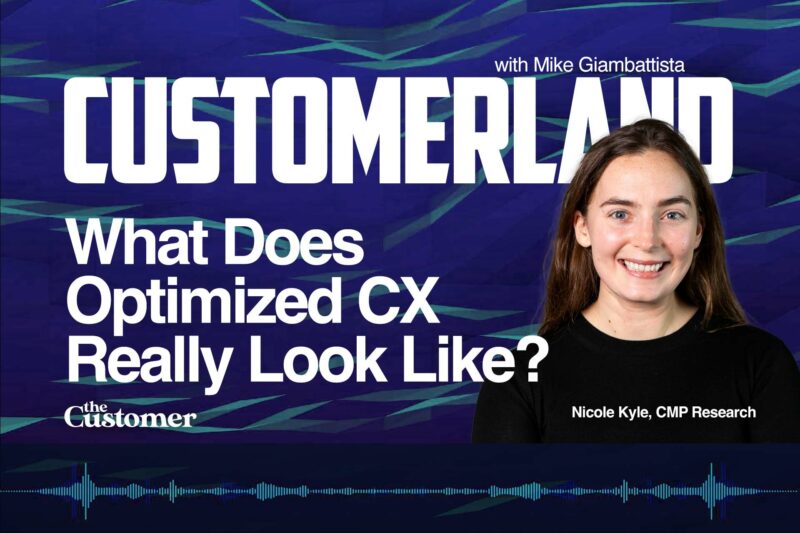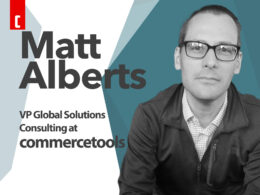Nicole Kyle is Managing Director and co-founder of CMP Research, the Customer Management Practice’s dedicated independent insights and research & advisory service. All of which means she has a lot to say about what’s working and what’s not in customer service and CX efforts, and how organizations are navigating the new customer “normal” which pretty much looks like it’s here to stay.
In this wide-ranging conversation, Nicole reveals what’s behind the latest data and how brands can leverage those insights to create better experiences and better relationships with their customers.
Full transcript below
Mike Giambattista:
Nicole Kyle is managing partner of C M P and co-founder of C M P Research. Nicole, thanks so much for joining me.
Nicole Kyle:
Thank you, Mike, for having me. Excited to be here.
Mike Giambattista:
Of course, we have a lot to talk about. I know that you’ve just released some research, which we’ll dig into in a minute, but if, maybe if you would just tell us a little bit about C M P and specifically C M P research, just to add context to what we will be talking about.
Nicole Kyle:
Sure, sure. So, customer Management practice is the leading events, research and community organization for customer executives. So when I say customer executives, we really run the gambit from customer contact leaders, customer service, and CX professionals and executives customer management practice. You or some of your listeners might be familiar with our leading event, customer contact week. That’s one of our flagship brands in our events, vertical. But C M P overall has three divisions. Events, as I mentioned, digital, which is our free online community based portal and organization. And then research, which is the division I head up. So, C M P research specifically is all about crowdsourcing from our customer contact community insight and information that is independent vendor agnostic, and really information that helps executives address their most urgent challenges. So we always like to say C M P research sits at the intersection of the future of work and customer contact, because that’s where a lot of the uncertainty is right now. But that’s, that’s what we do and, and who we are.
Mike Giambattista:
So the only thing that bothers me about what you just said is that this is our first time connecting. It seems like we should have been talking a long, long time ago.
Nicole Kyle:
I agree <laugh>,
Mike Giambattista:
Considering the overlap between, you know, what we cover and what you guys actually do. So your, your recently released white paper covered in my words executive expectations on how they will be investing themselves and their resources into customer engagement, customer experience initiatives and near terms. So I don’t want to give away the, the findings. I’d much rather hear you elaborate on them, but maybe we can just take it from the top. And I’m, I’m going off of some notes here. Number one, and I’ll just kind of throw this out to you and I believe these were prioritized from your research. Creating a frictionless customer experience and retaining talent are the top most urgent priorities for customer contact leaders. Kind of not that surprising in itself because, you know, customers are kind of the center of the universe here. Mm-Hmm. but that’s probably a change in priorities for a lot of people.
Nicole Kyle:
Yes. No, you’re absolutely right. It was really interesting doing the analysis this year. And for a little bit of context, we do this initiative and this analysis every year, and we ask on a one to two year time horizon. So those priorities you mentioned, creating a frictionless experience and retaining talent, that’s what our, you know, executive base said. You know, those are the top two things most important and most difficult for me to get right. In the next two years. Last year when we did this initiative, hiring talent was number one, and retaining talent was number two. So I think what that is a testament to is there’s been a lot of changes in the labor market in the last two or three years. There’s also changes in our current economic climate that’s, you know, maybe made hiring less of an issue. But that talent retention piece is still super top of mind. So yeah, we always talk about like the two sides of the customer coin. It’s the CX and it’s the agent X or employee experience. And those two things obviously reinforce each other. So we weren’t completely surprised to see those come up as the top two, but it was really telling to see frictionless CX, you know, outpace the more agent related things as we look into 2023 and 2024,
Mike Giambattista:
That that actually really is interesting. I’ve spoken to a number of people who operate in the CX world, CX ex world. Yes. And and they’re saying the same thing coming at it from different angles. Mm-Hmm. <affirmative>, I mean, yes, they’re, they’re inextricably intertwined mm-hmm. <Affirmative> but the priorities and kind of the, the ways that these various companies are waiting, those, those efforts are a little different. Really interesting. Can you, can you talk a little bit, I dunno, if the research got into this at all, how companies and these executives are planning to invest there? I mean, what are their tactical, you know pathways?
Nicole Kyle:
Yeah, for, for sure. So it was, it was so interesting because that top priority that, that you decided of creating a frictionless customer experience. Like that’s how we wrote it. But we also realized that is kind of like the ultimate goal, like the highest altitude goal for any customer leader. So when we looked through the list of other priorities and challenges we asked about, so things like managing technology transitions, reducing employee burnout improving the self-service experience, the, those are all sub drivers, I would say to an extent of either that frictionless CX or retaining your talent and offering a better employee experience. So as we went down that list and went down the priority list, managing technology transitions is number three. Number four is improving the self-service experience. And number five is reducing burnout. So we’ve dug into that a little bit more in conversation with our community base.
And that, especially that ultimate goal of removing friction technology transitions are cited as the hardest part of doing that, and specifically the technology suite and understanding what integrates with what and really cutting through the noise in the marketplace, frankly. So reevaluating tech investments, I suppose is kind of the short answer there as to one of the, the more tactical ways folks are looking at that. And then of course, that self-service point, huge area of focus for us coming up in the next year, because we know with the current economic pressure our executives are under moving more customer interactions to self-service is good. Not just for the business, but also good for the post covid customer who wants to be more self-sufficient. Right. So that’s where we start to get into some of the more tactical pieces.
Mike Giambattista:
I’m, I’m, I’m debating in my mind whether to go down this particular path. <Laugh> does take us off, off track here a little bit, but you said, I would just love to hear your thoughts on this. Not so much a debate, but just to hear your thoughts on it, that the, the phrase you used was something like creating a frictionless experience is basically the, the ultimate goal of anybody in CX or ex. And, and the notion I would just love to hear your thoughts on is that in, in basic storytelling, in actually even in CX in certain cases, it’s healthy to create certain kinds of strategic friction, friction points. And, and I mean even, even in architecture, they’ve, I’ve seen this played out where, you know spaces can be constrained somewhat kind of subtly so that they open up and you, you get a big aha moment, but you’re, you feel better. So it’s all about kind of manufacturing in those cases, manufacturing a situation where surprise and delight is a little bit more likely. But so yeah, that’s a dog leg from, from what we had anticipated. But I’d love to hear your thoughts on that. You know, is, is there for the, the modern enterprise level CX ex executive, is there a place for strategic friction? Or is that just so esoteric that it, let’s talk about it some other time?
Nicole Kyle:
No, I love the question, Mike. I think it’s fantastic. The short answer is yes, I do believe there is room for strategic friction. But, and the reason I feel that way is, well, look, number one, like the core of my research methodology in our team is we challenge assumptions, but in order to challenge assumptions, we have to know what those assumptions are. So from our executive analysis that we’re talking through and executives telling us, for the most part, you know, frictionless is ultimate goal. That sends up an immediate flag of, okay, that’s an assumption. We as an industry have that removing all or most friction is generally good. Will our research look into that assumption this year and try and challenge it? Absolutely. We wanna figure out is that a worthy assumption to hold or not? But more directly to your question, speaking to strategic friction, we have seen this and heard this a lot from our clients in industries where fraud of course is, you know, a high likelihood or a high risk.
So certainly for fraud mitigation, you want strategic friction you know, identity theft and all of that. So you see it a lot in financial services and insurance, of course. The other thing about strategic friction is we started to talk about this at a recent event with our community. If, if strategic friction is used as a means of educating the customer, or at least you are setting expectations as to why that strategic friction exists, the friction might have less of a negative impact than you originally thought. So sort of coming back to the fraud example, if in my self-service portal someone is trying to replace their credit card, like super oversimplified example and they have to go through six steps of identity verification and they’d otherwise be pretty frustrated in this, even though they’re doing it themselves, putting in little lines of, you know, why, why are we asking you this?
And then having an education moment of fraud rates have been increasing in industry in the last couple of years from X to Y adding an additional layer of verification helps us mitigate that. That might be friction, but it’s less of a harmful friction and less emotional because you’ve educated the customers why it’s happening. So I don’t have the perfect answer yet, but certainly something we wanna explore as we look into a, what are customer expectations around their self-service experience and around friction now, how much will they tolerate? How much will they not? Is it more or less than it was two years ago, three years ago? And secondly how do we then like actually operationalize that and put that into place? So yeah, it’s a fantastic question.
Mike Giambattista:
Well, I would love to stay close to the conversation on it because I think it’s those, those little esoteric things, otherwise esoteric things that, you know, the cumulative effect can really, can really create brand loyalty or it can cause it to dissipate mm-hmm. <Affirmative>. So that’s just me, but what do I know? I agree.
Sponsor Announcement:
- What could you achieve if you knew what your customers expected ahead of time?
- What if you could know what customers expect by category and by brand 12 to 18 months ahead of traditional brand tracking methods?
- And what if you could know exactly where to adjust and where to spend in order to drive the most benefit every time?
A customer expectation audit allows you to identify areas that require strategic reinforcement, as well as pinpoint which values will contribute most to an emotional bond with your brand and optimize accordingly. Customerland has partnered with Brand Keys, the world’s oldest loyalty focused consumer research firm to bring real world customer expectation audience to brands, brand managers, and to CX practitioners everywhere.
Want to know where your brand stands and exactly what to do about it. Go to expectationaudit.com, that’s expectation audit.com, and download a sample audit today.
Mike Giambattista:
Back to the regularly scheduled programming <laugh>. Yeah, one of your points here, and you mentioned it earlier, was managing technology transitions is the third most urgent priority. The tech suite is the biggest obstacle for creating a frictionless CX boy. Oh boy. Well, so I think that one sounds obvious in retrospect. I, I mean, I talk to, to technology providers and I talk to the people who implement them fairly frequently. Mm-Hmm. <affirmative>. I also talked to CX leaders who were tasked with like, not only kind of managing those implementations into their, into their staff, but what kinds of almost cultural changes they’re up against sometimes in order to, to implement that stuff. So it’s not just, Hey, here’s a new tool set. Oftentimes it’s, it’s more about like, we’re we have, we’re changing the way we think about this aspect of our customer engagement. I mean, do you find that, or is do you think that’s systemic? Do you think that is, you know, common? Or is that just kind of limited to whatever the culture of the company at the time?
Nicole Kyle:
No, I, I think it is common and, and we do see this the risks to a technology transition. It’s as much about the risk to your customer potentially as it is to the rest of your business, as it is to the risk, to your employee journey. It’s really been interesting for us to see how all of these urgent priorities we identified through the study, how they relate together. And one of the things is, one of the core reasons for employee burnout, agent burnout in the contact center is proliferation of tools and switching those tools so frequently. So you’ve got, you know, managing technology transitions is hard and mitigating agent burnout is hard, but unfortunately, one of those things is contributing to the other <laugh> doubly hard <laugh>. So that’s been really a, a takeaway observation for us. And then the other thing I’d say is, as we know, and understandably like tech moves fast, and in some ways the solutions may be moving faster than our use cases or our readiness, our tech readiness as an organization. So that’s another thing we we’re trying to, to help executives kind of combat.
Mike Giambattista:
So you just opened up another, another whole hornet nest of stuff here. But, you know, tech does move fast and we’ve seen that, I’m just call it the past, what, 90 days, 120 days with generative AI and chat G P T and its successors and the fact that the, the entire business world is either incredibly excited or incredibly anxious about what that means. And, and I don’t think, I don’t think CX or ex are immune to that. I mean, I’ve, you see it all over the place, but what’s your view on it? I mean, you know, is it a, is it a, well, what is your view on chat G P T and generative AI and the variants and, and how that can help now and what that might mean for the future of, of CX?
Nicole Kyle:
Yes, yes. So, gosh, my view on generative AI has a lot of dimensions. But the dimension most relevant to, to CX is certainly, I think it’s gonna help us as an industry. I think it’s going to help us become more efficient in terms of taking on some of the low value work or taking on, like if you think about the self-service interaction and self-service portals taking on some of that burden of writing up the first draft of what the FAQ portal should be for our customer, right? And might not be perfect, and it won’t be perfect the first time that the bot comes back with it, but it can get us, you know, 60% of the way there faster. So I think efficiency will certainly be improved. And I do think, like we’re seeing how it’s almost scary how smart the, the bots and variations are getting.
So we do expect AI driven, not AI assisted, but fully AI owned chatbots to become better. The big question mark in all of this is how long will it take us to see those efficiencies and those improved AI driven chat chatbot experiences with customers? We don’t know yet. And I, I do think it’s going to take a lot of time because we are early days in, in working out the kinks. It’s also a big part of our upcoming study on optimizing self-service for the postcode customer, because one of the, when we do our tech roadmap for customer contact executives, obviously one of the categories we’re looking at is AI chatbot and CU customer messaging features. So we’re taking that category, and as part of the research we’re doing between now and August 1st we are hoping to build a framework of investment criteria for these emerging generative AI solutions. So I don’t have that yet, and certainly it’s all order but we’re working on it because our, our clients and CX leaders, customer contact leaders are asking for it because it is a bit of a wild, wild west right now.
Mike Giambattista:
It, it really is. I’ll, I’ll just tell you anecdotally, like in fact, I was talking to a guy who runs the AI division of another CX technology provider, and like his, his full-time job is just to think about how we can leverage AI on behalf of our clients. And you know, in, in his view, I’m paraphrasing badly here, but in his view first of all, there’s nothing scary about it. You know, there’s a lot of panic out there and, and, and, and even research that’s predicting doom and gloom about, you know, job loss, et cetera. And he’s like, look, as far as I can see, the, the extent of, of his, of his what’s on his horizon personally is super hopeful in that it, it makes the, as you said, the the lower level tasks much more efficient. Mm-Hmm. <affirmative>. So, you know, do you frame it as well, the people who were performing those tasks are now out of a job? Probably not. I mean, it’s probably making their lives much easier and they can be deployed to something else which is more strategically important. Mm-Hmm. <affirmative>, the other way he put it, he said, look, you know, even if they replace me and my job and the only thing left for me to do is to go sit around on a beach while it does my job, for me, he is like, that’s really not that bad. Which <laugh> no, appreciate that perspective right now.
Nicole Kyle:
Yes. Certainly it’s, it is such a exciting opportunity for innovation, and I think, you know, I, I’d also be Remi to say, as seen with a lot of technology algorithms, for example, like there has been bi, when those move too quickly and are built too fast, a lot of bias can be built into them. And then that just perpetuates a lot of issues in terms of either employee experience and or customer experience and how our customers are dealt with, or how our employees are approached. And I think one of the reasons I, I kind of hope as an industry, and look, I’m not squarely in tech, I’m in customer contact and CX, but I hope as an industry tech maybe slows down or experiments a little bit more. Now is so that those same mistakes don’t necessarily repeat themselves. Because I think the power of generative AI is huge. And just making sure that we build it in a diverse way that our person’s, diverse customers and diverse employees is going to be very important. And I don’t have the answers there, but I, and I also think as executives being patient for that reason will serve us well in the long term. If, if that makes sense in terms of adoption.
Mike Giambattista:
It makes sense to me. And I think you’re echoing the sentiment of an awful lot of people. There was a, there’s a petition, if you will, that’s being signed by executives all over the world saying, please slow down. And for all those same reasons, you know, it’s, it makes sense. Mm-Hmm. <affirmative>, just to think right now, yes, I agree with you more, but those are the kinds of things I have, I have way too many baseless opinions on, and they probably need some foundation or to be tossed out, and you guys are actually addressing that. So
Nicole Kyle:
We’ll have a research interview with you for sure. Mike, I definitely wanna pick your
Mike Giambattista:
Brain up. I’m so honored. Thank you. No, well, you’re not gonna get anything but baseless opinion, I’ll just tell you right now. So, anyway. Well, Nicole, I really appreciate this. I, this is, this is great fun to talk about this. It is you and I both understand, I think intuitively that this is the, this is the center of the universe that all business revolves around. I don’t think I’m overstating that and wish everybody understood and had the same perspective, but I’m not kidding if you’re open to reconnecting in a couple of months or whenever your next research is released. I mean, I personally am fascinated by it and, and obviously can talk about it all day long, but more importantly, our readers and listeners love this stuff because it’s important to their businesses too. So thanks a million.
Nicole Kyle:
Thank you.













